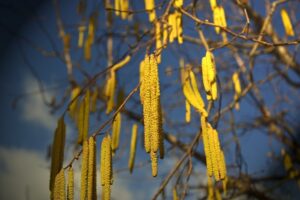European Hazelnuts, known for their rich, buttery taste, are a delightful addition to any garden. Not only do these trees provide an abundant harvest of delicious nuts, but they also play a significant role in sustainability and offer multiple health benefits. For those with a green thumb looking to cultivate this nut-bearing treasure, here’s a guide on how to grow European hazelnuts!
Introduction to European Hazelnuts
Corylus avellana, commonly known as the European Hazelnut, is a deciduous shrub that can reach up to 20 feet in height. The tree is notable for its ornamental catkins and, of course, its tasty nuts. European Hazelnuts are the primary species used in commercial cultivation due to their superior flavor and the size of their nuts, making them an excellent choice for those looking to venture into nut farming. These trees can live up to 80 years and start producing nuts at around 3 to 4 years old.
Benefits of Growing European Hazelnuts
Nutritional Value
European Hazelnuts are a rich source of various nutrients, including healthy fats, protein, dietary fiber, vitamins E and B, and minerals such as manganese, magnesium, and copper. This nutritional profile makes them a fantastic addition to a balanced diet.
Sustainability
Hazelnut trees are environmentally friendly, as they help prevent soil erosion, provide wildlife habitat, and can be integrated into agroforestry systems. The orchards also facilitate carbon sequestration, which is crucial for combating climate change.
Economic Benefits
Cultivating hazelnuts can be a lucrative venture. Hazelnuts are a high-value crop, with the global market for hazelnuts expanding due to increased interest in healthy eating and plant-based diets.
Growing Conditions for European Hazelnuts
Soil Requirements
Hazelnuts thrive in well-drained soils with a slightly acidic to neutral pH range. Sandy or loamy soils are best for root growth. It is essential to avoid heavy or compacted soils that can lead to root rot.
Climate Preferences
European Hazelnuts prefer temperate climates with distinct seasons. They can tolerate cold winters and mild summers suitable for nut development. Ideal growing regions generally experience more than 1,200 hours of chilling temperatures below 45°F.
Sun Exposure
Hazelnuts require full sun, typically at least six to eight hours a day, to produce a good yield of nuts. Insufficient sun can lead to poor nut production and a lack of vigor in the tree.
Planting and Maintenance
Planting Process
The best time to plant hazelnuts is in late fall or early spring. Dig a hole twice as wide and deep as the root ball. Spread the roots out in the hole and backfill it with soil to the same depth as the tree was originally planted. Tamp down the soil gently and water thoroughly.
Pollination Requirements
Hazelnuts are primarily wind-pollinated, requiring the presence of pollen-producing male catkins and female flowers on the same or nearby trees to fertilize and produce nuts. For optimal nut production, it is beneficial to plant different hazelnut cultivars close to each other to enhance cross-pollination. While hazelnuts can self-pollinate to a degree, cross-pollination between different varieties improves the quantity and quality of the nuts harvested. Establishing an environment that encourages natural pollinators, such as bees, can also support the pollination process, even though wind plays a primary role.
Watering Needs
Hazelnut trees require regular watering, especially during the first few years of growth. The trees should never be waterlogged, so ensure proper drainage. Once established, hazelnuts can withstand periods of drought.
Pruning Tips
Regular pruning is vital for disease control and maintaining an open canopy for better nut exposure and air circulation. Start pruning young trees to develop a good framework, and continue with light annual pruning to remove weak or dead wood.
Pest and Disease Management
Common Pests
Hazelnuts can be susceptible to pests like aphids, mites, and weevils. To control these, keep the area around the trees clean, use insecticidal soaps, or introduce natural predators like ladybugs.
Diseases
Hazelnuts are prone to several fungal diseases, including eastern filbert blight and shot hole. Disease-resistant cultivars are available, and proper site selection can help prevent many problems.
Preventive Measures
Maintain good orchard hygiene by removing debris and diseased plant material. Consider planting disease-resistant varieties or use fungicides as necessary.
Harvesting and Storage
Time to First Harvest
Hazelnut trees typically begin to bear fruit about 3 to 5 years after planting, depending on the variety and growing conditions. Optimal growth and early fruiting can be achieved through the correct planting site, adequate water, fertilizer, and proper care. Once mature, hazelnut trees can produce nuts for decades, making them an investment in the future of your garden or orchard.
When to Harvest
Hazelnuts are typically harvested in late summer to early fall. You’ll know they’re ready when the nuts start to drop from the tree. You can also check the nuts by cracking open a few. Harvest all the nuts when you begin to see nuts falling to the ground to prevent spoilage.
Storage Tips
Dry your hazelnuts after harvest and store them in a cool, dry place. They can be kept in the shell for up to a year, and shelled nuts can be stored in an airtight container for several months. Proper storage conditions will help maintain the nuts’ freshness and quality.
Conclusion
With the right knowledge and care, European Hazelnuts can be a delightful and sustainable addition to your garden or farm. By following these guidelines for growing, maintaining, and harvesting hazelnuts, you can enjoy their delicious taste while contributing to a greener planet. Happy hazelnut growing! For more variety of hazelnuts to grow check out my other article.

